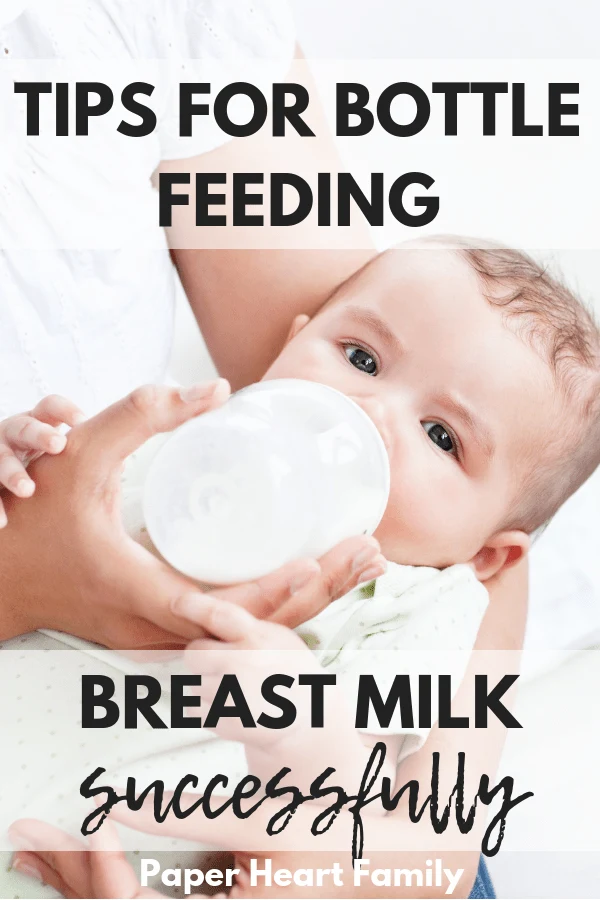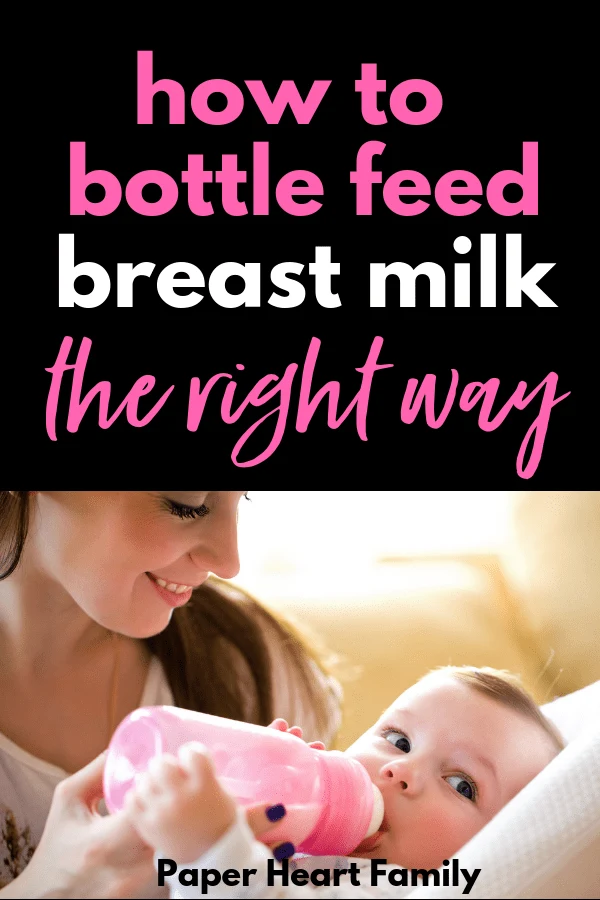Before I started breastfeeding, I didn’t realize that I didn’t really know anything about how to start pumping and bottle feeding breast milk. I thought, what can be so hard about it?
Truthfully, there is a lot to it!
You need to be knowledgeable when it comes to breastfeeding and bottle feeding expressed milk so that you don’t make any costly mistakes that could cause some major breastfeeding difficulties.
You need to know who should be feeding your baby, when you should introduce the bottle, what kind of bottle to use and how to collect, store, freeze and thaw the milk.
That’s a lot of stuff that you might not know at this time. Don’t worry, this guide will teach you everything you need to know.
This post contains affiliate links.
How To Start Pumping And Bottle Feeding Breast Milk

Tips For Pumping Breast Milk
I have written about how to maximize your pumping time and how to make pumping faster, but let’s assume that you are just starting and you need the most important, basic tips for pumping breast milk.
- Get a free, double electric pump from your medical insurance (read my reviews of breast pumps).
- If you are preparing to return to work, start slow and add in one pumping session per day. Consider doing this at a time when your milk supply is the highest (during a middle of the night feeding or first thing in the morning). Before your supply has regulated, pumping too much could cause an oversupply. It sounds good, however believe me, it’s NOT.
- Don’t start pumping too soon! It could cause some major problems. Find out the best time to start pumping breast milk.
- Be consistent in your pumping frequency and time of day so that your body becomes accustomed to producing extra milk at that time.
- Since you are still in the beginning stages of breastfeeding, make sure that you start at a low suction setting, to avoid adding to the pain you might be experiencing.
Related: Breastfeeding Pain Relief
- Maximize your time by pumping on one side while your baby nurses on the other. This technique is also helpful if you are having trouble responding to the pump as your baby will trigger a let down.
- Develop the perfect breastfeeding and pumping schedule with my tips that help whether you are a stay at home mom, building a stash or returning to work.
When Can I Give My Baby A Bottle Of Breast Milk?
Babies are much smarter than we think, and they can tell the difference between the breast and the bottle.
This could go either way. You could have a baby who prefers the bottle and then struggles to breastfeed, or you could have a baby who refuses the bottle because nursing is far superior and they know it.
Another breastfeeding problem that could arise is that your milk supply is negatively affected due to pumping too often before your supply has regulated (pumping isn’t as effective as nursing). Any feeding that your breastfed baby does in the first few weeks should be done at the breast in order to establish a healthy milk supply.
Introducing The Bottle To A Breastfed Baby
Introducing a bottle to a breastfed baby at the right time is crucial to (hopefully) avoiding any of these scenarios.
Most sources say that the idea time to introduce is between 4-6 weeks old. Earlier than that and you risk nipple confusion and a decreased supply, and later and you risk your baby refusing the bottle.
Other tips for introducing a bottle to a breastfed baby:
- Make sure that you are using a bottle specially formulated for breastfed babies. This bottle will have a slow flow and will have a nipple that mimics a natural breastfeeding latch. Using a bottle meant for breastfeeding babies will mean that your baby will be more likely to accept the bottle, and will help to avoid nipple confusion or bottle preference.
Related: Best Breastfed Baby Bottles
- Leave the house and let someone else bottle feed your baby- If your baby smells you, she might not go for the bottle at all. Remember what I told you: Babies are smart!
- Hold the baby in a different position than the position that you nurse in. You don’t want your baby to associate bottle feeding with breastfeeding and therefore refuse the bottle.
- Start with a small amount of breast milk and work your way up- While your baby is practicing and becoming accustomed to the bottle, there is no need to push your baby. Simply follow your baby’s lead. If she only wants to drink an ounce, that’s fine. Aim for a little more in the next feeding.
- Once you have introduced the bottle, do not go too long in between offering the bottle. If you only offer a bottle once a week, you might find that your baby will begin to refuse it at some point.
Bottle Feeding Breast Milk- How Many Ounces?
One of the many interesting things about pumping and bottle feeding breast milk is that the composition of the milk changes as your baby gets older. This means that unlike a formula fed baby, the amount that a breastfed baby drinks does not increase after the age of one month (with the exception of temporary increases due to growth spurts).
According to Kelly Mom, from 1-6 months of age, exclusively breastfed babies consume an average of 25 ounces of breastmilk daily (typically ranging from 19-30 ounces a day).
Then you simply need to do a little math in order to figure out how much your baby might drink in one feeding.
The typical breastfed baby of this age nurses 8 times a day (unless your baby was like mine who nursed approximately 264 times a day it seems).
Figure out how many times your baby nurses per day, then multiply it by 25. This gives you an approximate amount to start with.
How To Freeze Breast Milk
Freezing breast milk is thankfully fairly simple.
- First, decide whether you are going to freeze your milk in bags (I recommend Lansinoh breast milk storage bags as I never has any leaking issues) that allow your milk to be frozen flat (therefore saving room) or in glass or BPA-free bottles.
- Record the date and time that the milk was pumped.
- Record the amount (ounces).
Fun fact! Labeling the time of the day that you pumped isn’t necessary, but it might be a good idea. Breast milk composition changes throughout the day, meaning that in the morning it contains chemicals that help to wake your baby up and nighttime breast milk contains high levels of melatonin to encourage your baby to sleep.
Follow these guidelines for how long breast milk can be kept frozen:
- At room temperature- 4 hours
- In the refrigerator- 3 days
- In the deep freeze- 12 months, though 6 months is optimal
Also be sure to never refreeze your breast milk.
How To Warm Breast Milk
If you would like to know the best method for warming your breast milk:
- Do NOT thaw it in the microwave.
- Ideally thaw the breast milk in the refrigerator overnight. Otherwise you can thaw it in a container of warm water.
- Gently swirl the milk, do not shake or stir.
How Long Does Breast Milk Last After Warming?
This question might be the most important one of all, because after you go to all the trouble to pump milk for your baby, you want her to actually drink it!
I remember arriving at my mother-in-laws house on too many occasions only to see a bottle of 3 or even 4 ounces completely wasted because of my bottle refuser. They say don’t cry over spilled milk. I cried over thawed, unused milk.
Unfortunately, if your baby has already partially consumed the bottle of breast milk, due to a lack of studies done on the issue and the fact that bacteria from the baby’s mouth mixes with the milk, it is recommended that any unused milk be discarded.
This is why it is SO important to freeze in small quantities.
If you have warmed the milk but have not yet fed it to your baby, it should be consumed within one hour.
Learn more about breast milk storage guidelines.
What To Do When Your Breastfed Baby Is Refusing The Bottle
If your breastfed baby is refusing the bottle, then I am so very sorry. I know how stressful it can be.
My first baby absolutely refused to drink more than 3 ounces total during the 7 ½ hours that I was away from her. Albeit, she did it happily, but still.
I was stressed. She was small and slow to gain weight as it was, and I just wanted her to DRINK THE MILK. The milk that I was painstakingly pumping for her religiously during my precious free time at work.
I can tell you from experience that some babies will NOT change. (Just imagine if your baby is this headstrong at 2 months old how independent she’ll be as an adult.)
However, some babies are more likely to be coaxed to accept the bottle.
Here’s what you can do:
- Try different bottles.
- Make sure that the baby isn’t overly hungry.
- Try different positions.
- Make sure that the nipple flow isn’t too fast or too slow.
- Make sure that the temperature is right. My baby (temporarily, mind you) drank more when my mother-in-law started to warm it a little more than before.
- If at first you don’t succeed, try, try again!
Have any other questions about how to start pumping and bottle feeding breast milk? Leave them below and I’ll be sure to answer!


Newborn Won't Sleep Unless Held? 15 Techniques To Try!
Monday 17th of April 2023
[…] you breastfeed or bottle feed to […]
Best Bottles for Breastfeeding Babies (Even the Stubborn Ones)
Sunday 9th of April 2023
[…] The right bottle is extremely important, but there is more to it than just that. Read this post to learn everything else that is essential when it comes to bottle feeding breast milk. […]
How To Store Breast Milk After Pumping
Sunday 9th of April 2023
[…] Related: How To Bottle Feed Breast Milk […]
The Most Common Breastfeeding Problems And Tips For Avoiding Them |
Friday 24th of June 2022
[…] more about feeding breast milk in a bottle to find out how long your breast milk is good for, how much your baby should be drinking and how to […]
When Should You Start Pumping Breast Milk For Baby?
Thursday 23rd of June 2022
[…] Related: How To Start Pumping And Bottle Feeding Breast Milk […]